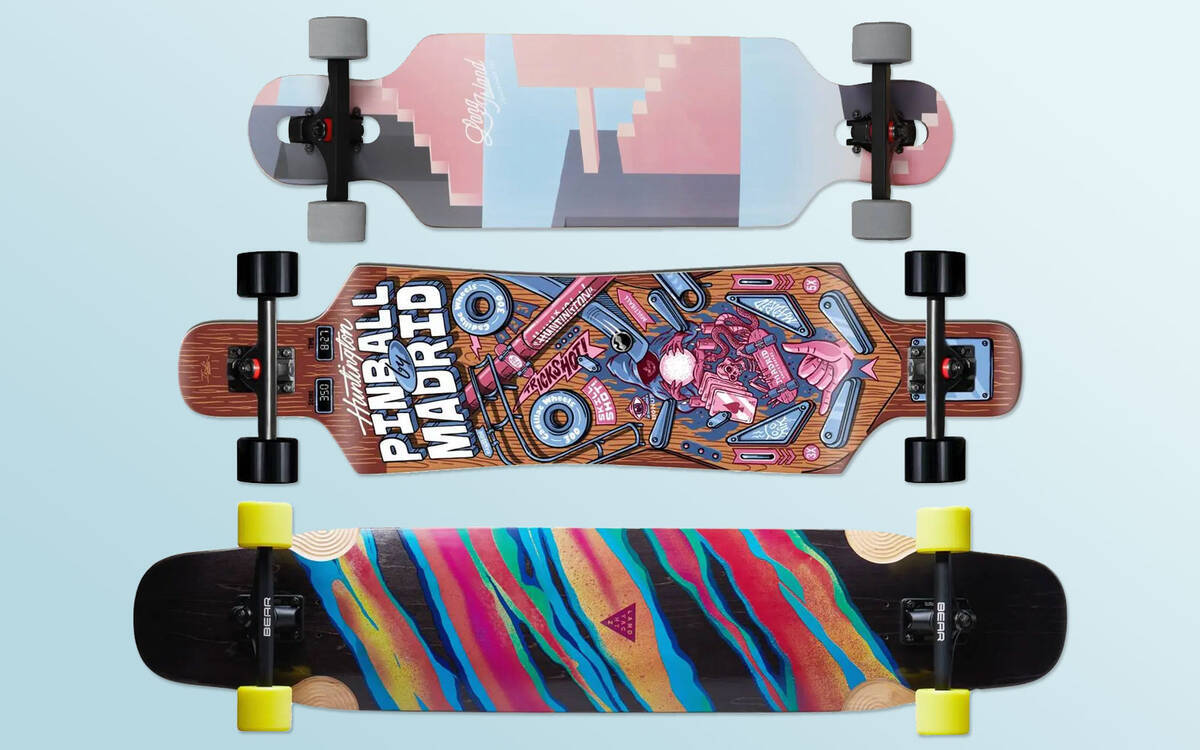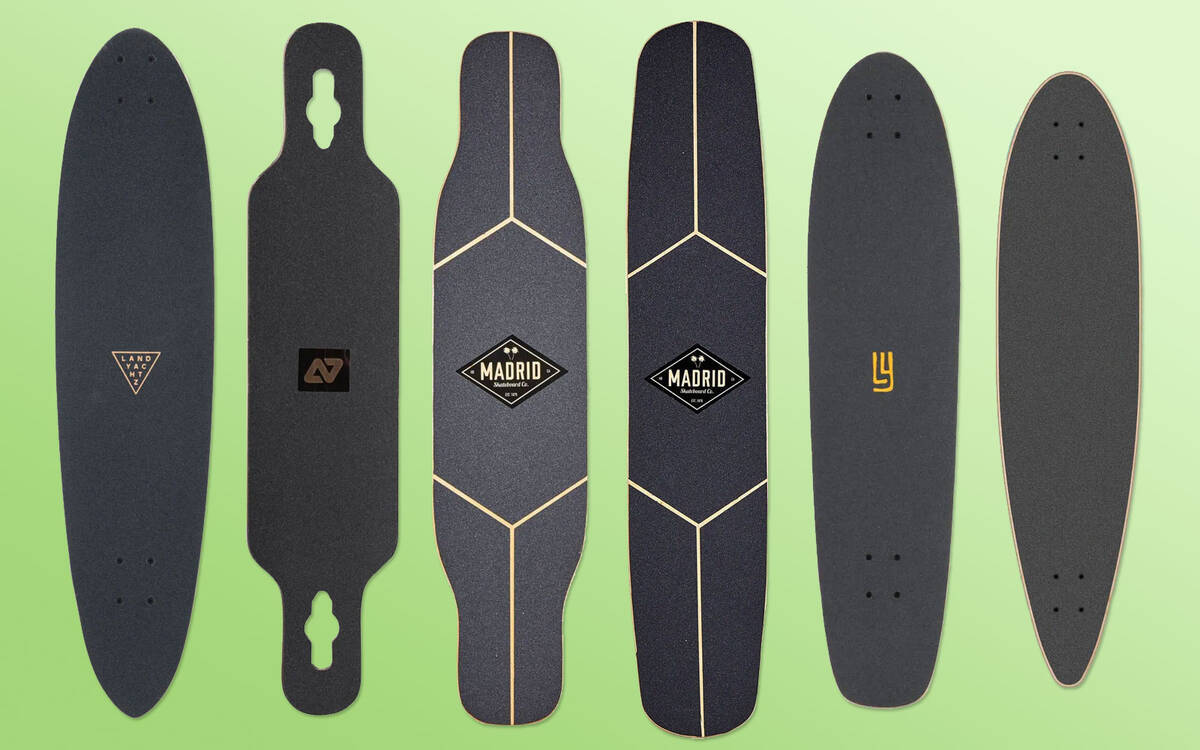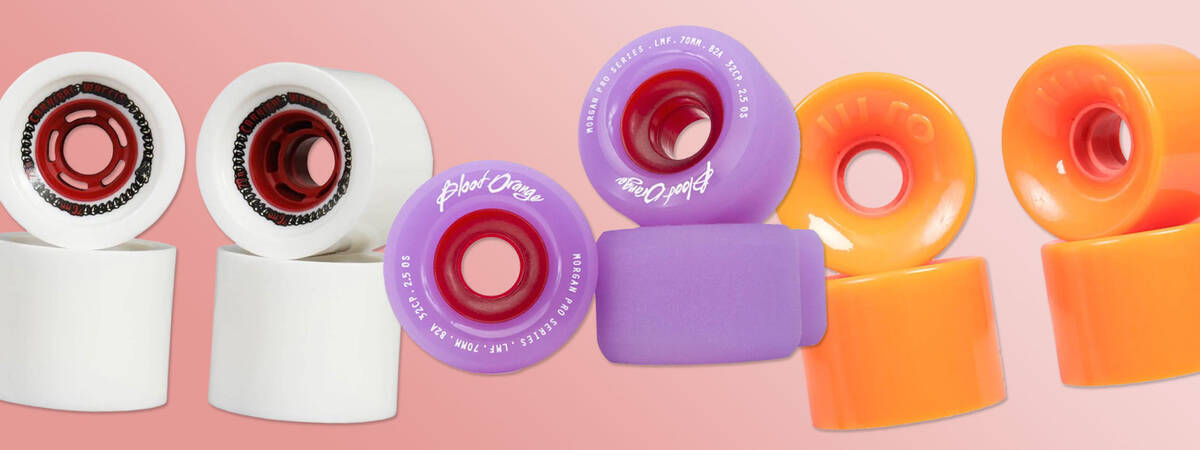Longboard Buying Guide - Choosing the Best Longboard for You
Be it a complete longboard for a newcomer you seek, or you're an established longboarder keen to upgrade or improve your ride, this guide is packed with essential insights into longboards.
There's no requirement to go through this guide start to finish (your passion is for long boards, not lengthy guides). We provide ample details on our product pages to help you choose the right longboard. Feel free to check out our range of complete longboards right away.
If any particular element of longboarding gear interests you, use the content list below to navigate directly to that topic:
Overview
Overview
Varieties of Longboards - Which Longboard Should I Pick?
The various kinds of longboards cater to different longboarding styles. When buying a complete longboard, understanding the basic types and disciplines of longboarding can be advantageous.
Choosing a longboard instead of a skateboard usually suggests you're after a smooth ride or you're attracted to one of the more specialized longboarding disciplines, like longboard dancing or downhill riding.
Your longboard choice should reflect your favoured longboarding style. In the upcoming sections, we will examine the key aspects of various longboard disciplines and the types of boards linked with each. Read on for detailed information about the different longboard types. We've categorised them into six groups to make choosing the right longboard easier for you!
Longboard Cruisers & Carving Longboards
Longboards for cruising and carving often have many shared traits. Cruising is about leisurely riding your longboard, whereas carving involves swaying side to side to regulate speed, similar to how a snowboarder carves down a slope.


If cruising is your thing, you probably have an interest in carving too. Cruiser decks often have pintail structures. This shape is excellent for a cruiser deck, whether you're commuting or taking a laid-back ride around your area. Longboard cruisers focus more on stability and smooth riding than tricks.
While cruiser longboards suit beginners well, carving might be the subsequent step from cruising.
Downhill Longboards & Freeride Longboards
Downhill longboards demand stability to avoid speed wobbles, necessitating rigid decks and broad trucks. To reach high velocities while reducing accident risks from road irregularities or unexpected slides, the finest downhill longboards are equipped with large, wide, and soft wheels.

Freeride longboards, in contrast, are slightly more versatile than downhill boards. Though intended for quick downhill runs, freeride longboards also prioritize maneuverability for technical sliding. Therefore, they share several features with downhill boards. But while downhill boards focus on speed and stability, freeride boards add agility and maneuverability into the equation, particularly for sliding and carving.

Using protective gear is crucial for both freeriding and downhill longboarding.
Freestyle Longboards
Freestyle longboards put emphasis on technical moves and artistic tricks instead of speed. Generally, they feature symmetrical shapes with kicks at each end, allowing tricks and riding in any direction - thus, they are bi-directional. Wheels on freestyle configurations are harder and smaller than those on other longboard setups since the focus here isn't on speed or distance.

Freestyle longboarding focuses on creativity and expanding the boundaries of longboarding possibilities. If you enjoy skateboarding, you'll probably be drawn to freestyle longboarding too.
A freestyle longboard is an excellent option if you aim to perform tricks and perhaps enjoy a bit of cruising as well.
Dancer Longboards
Dancer longboards cater to those who blend graceful moves and rhythmic finesse on a longboard. They are designed for the artistry of longboard dancing, integrating smooth movements, skilful footwork, and expressive style.
The top decks for dancing have symmetrical, bi-directional shapes and are the longest among longboard types, providing ample foot space for stunning moves, with kicks situated at both ends.

Dancing on a longboard necessitates a versatile setup, ideally with a medium flex and responsive trucks, ensuring a balance between stability and agility, perfect for executing impressive footwork.
If you're charmed by the rhythm of dance and exhilaration of exceeding your limits, a dancer longboard is your ally for self-expression on roads and pavements. Embrace the rhythm, unleash creativity, and move to the pavement's beat with the ideal dancer longboard.
When browsing our collection of complete longboards, you can filter them by riding style.
What Size Longboard is Right for Me?

The ideal longboard size naturally relates to your riding style. While skateboarders often use shoe size for deck width, for longboarders, it's more about the riding style than height or shoe size. Take downhill longboarding, for example, which typically uses much shorter decks than longboard dancing. Hence, rather than relying solely on measurements, focus on your preferred style to determine the right size.
However, if you're a shorter rider with small feet, a shorter board might suit better, while taller individuals with larger feet could prefer a longer version of a similar longboard. It's all about finding the perfect balance for your proportions and style.
Longboard Wheelbase

The wheelbase is the span between the front and rear wheels. Though deck length hints at the wheelbase, they aren't directly proportional, as features like kick tails can extend deck length without affecting wheelbase length.
Longer wheelbases provide wider turning circles, whereas shorter wheelbases result in tighter turns.
- Larger wheelbase: Yields a stable setup with slower turns, facilitating easier control and prediction of behaviour during slides. Yet, this stability taxes agility.
- Shorter wheelbase: Delivers an agile but less stable setup due to smaller turning circles.
Notably, some longboard decks come with adjustable wheelbases, featuring eight or more truck-mounting holes, allowing mounting closer or further apart.
Longboard Deck Shapes

Understanding the unique qualities of longboard deck shapes and features is crucial for selecting a deck that complements your riding. Recognising how certain shapes aid or impede your style is vital for making informed decisions.
Pintail Longboard
Pintails are prevalent on cruiser longboards that promote a surf-style riding experience. Named after pintail ducks because of their characteristic point, pintails' popularity is boosted by their resemblance to surfboard shapes. While pintails might not suit freestyle longboarding, they offer enjoyment to those after an agile board for cruising and carving.
Drop Down Longboard
Drop-down decks have lowered platforms between the trucks, lowering the centre of gravity. This design provides advantages such as reduced pushing effort and less responsive steering for beginners. It also results in a longer wheelbase, as you can't stand directly over trucks, facilitating easier slide initiation.
Beginners and those fond of cruising, carving, or freeriding favour drop-down longboard decks. But a deck without the drop is preferable for downhill speed enthusiasts.
Double Drop Longboard
Double drop decks combine a lowered platform with drop-through truck mounting, achieving a particularly low centre of gravity, which enhances stability and eases pushing, sliding, and balance at moderate speeds.
A double drop deck is ideal for those emphasising proximity to the ground, excelling in cruising, freeriding, and sliding. These longboards suit beginners for their stability, as well as advanced riders for their outstanding sliding and freeride prowess.
Wheel Wells on Longboards
On some decks, you'll notice wheel wells, which are concave scallops close to the wheels. Wheel wells offer wheel clearance during tight turns or deep carves, preventing wheel bites.
Longboard Cutouts
Cutouts are deck portions removed to provide space for larger wheels and avoid wheel bite, essentially eliminating wood over the wheels on a longboard by cutting sections away, thus eradicating wheel bite risks.
Longboard Kicks & Double Kick Longboard Decks
Longboard kicks are elevated tips at both deck ends, common on dancer and freestyle longboards. They facilitate manoeuvres like ollies, manuals, and kickturns, expanding the possible tricks range. Double kick decks are indispensable for dancer and freestyle setups.
Drop-Through Longboards
Drop-through longboards mount trucks through the deck, reducing ride height and lowering the centre of gravity. This setup boosts stability, simplifies pushing and sliding, and eases fatigue during extended rides. Drop-through boards are ideal for freeriding, cruising, commuting, and carving.
Drop-through decks have openings to allow "dropping" baseplates from the deck's top. Assembling trucks onto a drop-through deck demands hangers' detachment from baseplates.
For drop-through configurations, favour genuine Reverse Kingpin (RKP) Longboard Trucks instead of typical street skateboard trucks to guarantee peak performance.
Drop Through vs. Top Mount Longboard


It's critical to discern the differences between top mount and drop-through setups as these heavily influence your riding experience.
Top-mounting refers to the attachment of trucks directly to the base of the deck, situating the deck on top of the trucks. This arrangement offers improved leverage and responsiveness, ideal for carving, freestyle, and maximum manoeuvrability.
Conversely, drop-through mounting involves securing the trucks through openings in the deck, allowing them to suspend lower than the surface of the deck. This results in a lowered centre of gravity, providing increased stability and easier pushing, as the pushing foot is nearer to the ground. It also simplifies sliding.
Drop-through longboards include cutouts near the wheels to ensure wheel clearance, which is crucial given the deck's lower position. These cutouts on drop-through decks prevent wheel bites and enable smoother turns and manoeuvres by allowing the wheels to sit flush with the underside of the deck.
Ultimately, your choice between drop-through and top-mount configurations relies on your riding preferences and style. Should stability and speed be your priorities, a drop-through deck might be more appropriate. However, if manoeuvrability and responsiveness are more important, a top-mount deck may better suit you.
While exploring our collection of longboard decks, you can spot drop-through decks by the substantial holes where the trucks are installed.
Insight into Longboard Trucks

The most suitable longboard trucks for you align closest with your riding style. Various features of the trucks can considerably affect the specifications of your setup. The most significant considerations in longboard trucks are kingpin orientation, baseplate angle, and hanger width.
RKP vs TKP Trucks: An Overview
The acronyms RKP and TKP commonly refer to the primary differences in kingpin placements on longboard trucks. Here's what they stand for:
- Reverse kingpin trucks (RKP) are often simply labelled as longboard trucks as they excel in numerous aspects of longboarding, unlike skateboards. RKP trucks have the kingpin directed away from the setup's centre, offering stability alongside agile and smooth turns. Naturally, an RKP truck sits higher compared to a TKP truck.
- Traditional kingpin trucks (TKP), also known as classic or vertical kingpin trucks, are typically associated with skateboarding and are seldomly used in longboarding. The design of TKP trucks places the kingpin lower than the hanger, making them ideal for grinding.
Choosing between RKP and TKP trucks primarily revolves around turning characteristics. Reverse kingpin trucks are celebrated for their control ease at faster speeds, often regarded as more "predictable" during high-speed turns compared to traditional kingpin trucks.
Understanding Baseplate Angle in Longboard Trucks

A longboard truck's baseplate angle refers to the angle between a line parallel to the baseplate and a line running from the pivot cup toward the hanger.
The baseplate angle significantly influences your longboard's overall characteristics:
- Smaller baseplate angle: This angle results in a larger turning radius, meaning reduced sharpness in turns, making you lean the deck more for turns. This feature enhances stability and reduces wobble risk at high speeds. Therefore, for a setup more focused on stability, a lower baseplate angle is advised.
- Larger baseplate angle: This angle offers more agile trucks with a reduced turning radius, facilitating sharper turns with minimal effort. High baseplate angles make initiating turns simpler, improving longboard steering. Beginners learning essential longboarding skills, like pushing and turning, may find a larger baseplate angle more appropriate.
Our range of longboard trucks can be filtered through baseplate angle, simplifying your search for the ideal ones.
Decoding Longboard Bushings

Longboard bushings, small doughnut-shaped pieces made of polyurethane, reside inside the truck's hanger. They play an essential role in defining the board's responsiveness and stability, available in a range of shapes, sizes, and durometers (degrees of hardness) for riders to tailor their board's feel and performance.
Bushing hardness:
- Soft bushings: Allow more turning and carving.
- Firm bushings: Provide greater stability at accelerated speeds.
Bushing varieties:
- Cone bushings: Available in both short and lengthy versions, cone bushings are noted for their responsiveness and often appear in setups designed for cruising and carving.
- Barrel bushings: Barrel bushings impart more stability to trucks and reduce turn inclination.
- Eliminator bushings: These remove space for the trucks' unwanted movements and are ideal for riders in pursuit of a stable, high-speed setup or those desiring extra bushing support. Their design fills the entire bushing seat and overlaps above the bushings' edges. Consequently, softer bushings can be used without sacrificing control at speed.
Altering bushings can significantly impact your setup, making them a crucial aspect to consider when optimising setup characteristics.
Sizing and Width of Longboard Trucks
Ideally, your trucks' width should match your deck's at its broadest point. If the trucks or wheels protrude too far, it could lead to challenges like striking the wheels when pushing.
Determining appropriate truck width for your longboard deck involves considering axle width, as it influences the trucks' overall breadth. At SkatePro, axle width is noted among truck specifications to make selection easier.
- Narrower longboard trucks: Provide enhanced agility and responsiveness.
- Wider longboard trucks: Deliver greater stability and are easier to manipulate at speed.
Our collection includes all necessary components for your longboard trucks, including parts, risers, and bushings:
All About Longboard Wheels

For many longboarders, selecting the best wheels is paramount. Not only do wheels greatly influence riding characteristics, but they also are available in a vast range of colours and intriguing designs, which stimulates a distinct level of commodity fetishism amongst enthusiasts.
Focusing on vital aspects, here we discuss how longboard wheel specifications affect your riding experience:
Longboard wheels are generally comprised of polyurethane, a versatile plastic material available in various forms. Each wheel manufacturer uses unique formulas to create longboard and other skate wheels. These are meticulously developed to confer wheels with specific traits enhancing the riding experience.
Wheel size, hardness, and shape are crucial factors when choosing longboard wheels.
Exploring Longboard Wheel Size
When deciding on the perfect longboard wheel size, understanding how size affects speed, momentum, ride smoothness, and manoeuvrability is essential:
Speed and momentum:
- Large wheels: Offer higher top speeds and maintain speed better.
- Small wheels: Provide lower top speeds but faster acceleration.
Ride smoothness:
- Large wheels: Feature a gentler curvature and a larger surface to absorb irregularities, ensuring a smoother ride.
- Small wheels: Strike irregularities at a steeper angle, increasing the likelihood of abrupt stops when encountering cracks or pebbles.
Manoeuvrability:
- Large wheels: Generally less manoeuvrable yet more stable.
- Small wheels: Enhance agility and are easier to steer, boosting overall manoeuvrability.
Weight:
- Larger wheels: Weigh more than smaller wheels.
Sliding attributes:
- Larger wheels: Harder to initiate slides, requiring more effort for control during slides.
- Smaller wheels: Simplify entering slides and provide easier control while sliding.
To determine the right size for your longboard wheels, several factors must be considered. Ensure that the rest of your setup complements the chosen wheel size, particularly avoiding wheel bites. If in doubt, consider adding a pair of risers:
Assessing Longboard Wheel Hardness
Longboard wheels are evaluated by their hardness, using a durometer rating applied to all skate wheels. A higher durometer indicates harder wheels. Understanding the importance of wheel hardness is essential, so ensure to verify this rating when acquiring new wheels or purchasing a complete longboard equipped with pre-selected wheels.
Here's a concise overview of hard versus soft longboard wheels:
- Hard longboard wheels: Provide less grip, slide more easily, and are less effective at absorbing vibrations.
- Soft longboard wheels: Provide more grip, are less prone to sliding, and effectively absorb vibrations.
Typically, longboard wheels range between 78A and 85A, considered relatively soft compared to regular skateboard wheels. This softness is vital for longboarding on rough surfaces at accelerated speeds.
Longboard Wheel Width & Shape Explained
The wheel's width and shape define the contact patch—where your wheels meet the ground during rides.
- Wide contact patch: Ensures more grip.
- Narrow contact patch: Offers less grip, simplifying sliding.
The edges, or lips, significantly impact longboard wheel performance, determining the contact patch size. Wheels with sharp edges have wider contact patches than those with rounded or beveled edges.
- Longboard wheels with sharp edges boast a wider contact patch, increasing grip and stability at speed.
- Longboard wheels with beveled or rounded edges feature narrower contact patches, enhancing slide ease and delivering lighter weight, resulting in improved agility and manoeuvrability.
Finding the Perfect Longboard Wheels
Consider size, hardness, and shape to choose the best wheels for your setup. Theory may not always translate to practice, but experimentation with new wheels will continue throughout your longboarding journey.
Frequently asked questions regarding specific longboard wheels are as follows:
Which Longboard Wheels are Best for Sliding?
Searching for slide wheels should lead you towards smaller wheels with hard durometers (up to approximately 85A), and a narrow contact patch featuring bevelled or rounded edges.
How to Select the Best Longboard Wheels for Cruising?
When cruising, it's important to focus on smooth-rolling wheels that effectively reduce vibrations on uneven surfaces. Choose softer wheels (74A - 78A) that are fairly large (65 - 70 mm). For optimal grip, go for wheels with sharp edges; if you prefer more agility and smoothness, consider those with rounded or beveled edges. This will provide you with the ideal cruiser or commuter wheels.
Selecting the Ideal Longboard Wheels for Dance and Freestyle
For performing dance moves and tricks, prioritise wheels that offer easy control and are lightweight. In the realm of longboard dancing and freestyle, agility and manoeuvrability are more critical than speed and stability. Choose wheels with a diameter of about 65 mm and rounded or beveled edges, paired with a soft durometer rating.
